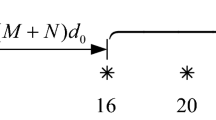Abstract
Higher degrees of freedom (DOF) for direction of arrival can be attained by using coprime arrays. In this paper, we design super-resolution generalized coprime array configurations based on suppression and displacement to achieve higher DOFs. The first composition known as CASDiS stands for coprime arrays with suppressed and displaced subarrays. This structure can achieve \( 4MN + 1 \) number of consecutive lags considering only \( 2M + N \) number of sensors. However, still there are some holes. In order to achieve hole-free lags, a novel nested inspired “Nested Displaced CoPrime subarrays” (NesDCoP) structure is designed. This configuration performs remarkably in terms of generating consecutive lags and can triumph hole-free \( 4MN + 2M + 1 \) lags. The key contributions of this work are as follows: Firstly, both array configurations can achieve longer consecutive lags as compared to previously proposed arrays. Secondly, NesDCoP structure can accomplish consecutive lags almost equivalent to nested arrays. Lastly, both structures are less complex because there is no need to use interpolation techniques. The practicality of these configurations is demonstrated using MUSIC algorithm, and then, simulation results are equated with other methods which show the effectiveness of both the proposed array configurations.








Similar content being viewed by others
References
Y. Abramovich, N. Spencer, A. Gorokhov, Positive-definite Toeplitz completion in DOA estimation for nonuniform linear antenna arrays—part II: partially augmentable arrays. IEEE Trans. Signal Process. 47(6), 1502–1521 (1999)
F.M. Han, X.D. Zhang, An ESPRIT-like algorithm for coherent DOA estimation. IEEE Antennas Wirel. Propag. Lett. 4(1), 443–446 (2005)
H. Krim, M. Viberg, Two decades of array signal processing research: the parametric approach. IEEE Signal Process. Mag. 13(4), 67–94 (1996)
Y. T. Lo, A mathematical theory of antenna arrays with randomly placed elements, in IEEE Transactions on Antennas and Propagation, vol AP-12, pp 257–268 (1964)
J. Liu, Y. Zhang, Y. Lu, Augmented nested arrays with enhanced DOF and reduced mutual coupling. IEEE Trans. Signal Process. 65, 5549–5563 (2017)
J. Li, X. Zhang, Direction of arrival estimation of quasi stationary signals using unfolded coprime array, in IEEE Access, vol 5, pp 6538–6545 (2017)
C.L. Liu, P.P. Vaidyanathan, P. Pal, Coprime coarray interpolation for DOA estimation via nuclear norm minimization, in IEEE International Symposium on Circuits and Systems (2016)
A. Moffet, Minimum-redundancy linear arrays. IEEE Trans. Antennas Propag. 16(2), 172–175 (1968)
T.H. Al Mahmud, K. Shabir, R. Zheng, Z.F. Ye, Interpolating coprime arrays with translocated and axis rotated compressed subarrays by iterative power factorization for DOA estimation. IEEE Access 6, 16445–16453 (2018)
M. Pesavento, A.B. Gershman, M. Haardt, A theoretical and experimental performance study of a root-MUSIC algorithm based on a real-valued Eigen decomposition. IEEE Trans. Signal Process. 48(5), 1306–1314 (2000)
P. Pal, P.P. Vaidyanathan, Nested arrays: a novel approach to array processing with enhanced degrees of freedom. IEEE Trans. Signal Process. 58(8), 4167–4181 (2010)
P. Pal, P. P. Vaidyanathan, Coprime sampling and the MUSIC algorithm, in Proceedings of IEEE Digital Signal Processing Workshop and IEEE Signal Processing Education Workshop (Sedona, 2011)
P. Pal, P. P. Vaidyanathan, On application of LASSO for sparse support recovery with imperfect correlation awareness, in Proceedings of Asilomar Conference Signals, Systems and Computers (Pacific Grove, 2012)
P. Pal, P.P. Vaidyanathan, Pushing the limits of sparse support recovery using correlation information. IEEE Trans. Signal Process. 63(3), 711–726 (2015)
S. Qin, Y. Zhang, M. Amin, Generalized coprime array configurations for direction-of-arrival estimation. IEEE Trans. Signal Process. 63(6), 1377–1390 (2015)
S. Qin, Y.D. Zhang, M.G. Amin, DOA estimation exploiting coprime frequencies, in Proceedings of SPIE Wireless Sensing, Localization, and Processing Conference, vol 9109 (Baltimore, 2014)
R. Roy, T. Kailath, ESPRIT-estimation of signal parameters via rotational invariance techniques. IEEE Trans. Acoust. Speech Signal Process. 37(7), 984–995 (1989)
R.O. Schmidt, Multiple emitter location and signal parameter estimation. IEEE Trans. Antennas Propag. 34(3), 276–280 (1986)
Z. Shi et al., Source estimation using coprime array: a sparse reconstruction perspective. IEEE Sens. J. 17, 755–765 (2017)
T.E. Tuncer, T.K. Yasar, B. Friedlander, Direction of arrival estimation for nonuniform linear arrays by using array interpolation. Radio Sci 42(4), 1–11 (2007)
P.P. Vaidyanathan, P. Pal, Sparse sensing with co-prime samplers and arrays. IEEE Trans. Signal Process. 59(2), 573–586 (2011)
Y. Zhang, B.P. Ng, MUSIC-like DOA estimation without estimating the number of sources. IEEE Trans. Signal Process. 58(3), 1668–1676 (2010)
Y.D. Zhang, M.G. Amin, B. Himed, Sparsity-based DOA estimation using co-prime arrays, in Proceedings of IEEE ICASSP (Vancouver, 2013)
Y.D. Zhang, M.G. Amin, F. Ahmad, B. Himed, DOA estimation using a sparse uniform linear array with two CW signals of co-prime frequencies, in Proceedings of IEEE International Workshop on Computational Advances in Multi-Sensor Adaptive Processing (Saint Martin, 2013)
C. Zhou et al., Compressive sensing based coprime array direction-of-arrival estimation. IET Communication Letter 11, 1719–1724 (2017)
Y.D. Zhang, S. Qin, M.G. Amin, DOA estimation exploiting coprime arrays with sparse sensor spacing, in IEEE International Conference on Acoustic, Speech And Signal Processing (2014)
Acknowledgements
This work is supported by CAS-TWAS fellowship, the National Natural Science Foundation of China under Grant 61671418, and advanced research fund of University of Science and Technology of China.
Author information
Authors and Affiliations
Corresponding author
Additional information
Publisher’s Note
Springer Nature remains neutral with regard to jurisdictional claims in published maps and institutional affiliations.
Rights and permissions
About this article
Cite this article
Shabir, K., Al Mahmud, T.H., Zheng, R. et al. Generalized Super-resolution DOA Estimation Array Configurations’ Design Exploiting Sparsity in Coprime Arrays. Circuits Syst Signal Process 38, 4723–4738 (2019). https://doi.org/10.1007/s00034-019-01078-1
Received:
Revised:
Accepted:
Published:
Issue Date:
DOI: https://doi.org/10.1007/s00034-019-01078-1




